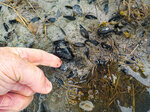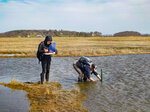





YOU MAY HAVE READ in these articles on the Great Marsh details on the salt marsh restoration work that is underway in the Great Marsh.
This work includes regeneration of native salt marsh plants through the control of infestations of Phragmites and pepperweed, sand dune vegetation for storm erosion stabilization, eelgrass recovery for sediment stability in channels and habitat for our beloved bivalves, marsh hydrologic improvements such as mosquito ditch remediation and the draining of overfilled salt marsh mega-pools, necessitated by rising seas, as well as a host of other state-of-the-art marsh protection research and restorative projects.
This work is being done to protect, restore, and enhance the Great Marsh. However, this effort is a relatively new endeavor. As a concerted practice, broad stakeholder collaboration activity is only a decade old.
Not that long ago, the Great Marsh wasn’t even known as the “Great Marsh”, and it was not cherished by many of us as a relevant ecosystem with a value much greater than its recreational and economic opportunities to those who boated, fished, hunted, clammed, and birdwatched.
The term “Great Marsh” is only 25 years old. Before that, to most, it was simply the marsh or swamp you passed by on your way from here to there. The name was first coined by Ruth Alexander, a Rowley resident and prominent salt marsh advocate. “Great Marsh” did not enter the household vocabulary until about ten years ago, thanks to the outreach and education mission of the Great Marsh Coalition. This ad hoc organization of environment advocates, agencies, and nonprofits had an original mission to promote the Great Marsh and all its attributes.
However, over the last 20 years the Coalition, while still keeping its outreach focus, has expanded into discussions of climate change, municipal engagement in sea level rise, student involvement in the marsh, and other Great Marsh centric education.
Back in the early 1990’s a group known as the Eight Towns and the Bay Committee was formed. The Bay, in this case, is Ipswich Bay. The Eight Towns are actually the nine coastal communities of the upper North Shore (the ninth town joined after the Committee’s name was coined.)
The name has since been changed to the Eight Towns and the Great Marsh (8TGM), which better defines the Committee’s geography and mission. This local governance committee was formed as a result of a larger effort to bring recognition and oversite to all coastal estuaries and their watersheds within the Massachusetts Bay estuaries; a region traversing from the New Hampshire border to Cape Cod. Membership in the 8TGM committee consists of official municipal representatives from each of the nine communities, local environmental advocates, and education/outreach representatives (we are always looking for additional volunteers).
The early direction of this Committee was more terrestrial than estuarine. Efforts such as stormwater mitigation, water quality, low impact design zoning, and occasional coastal outreach were the emphasis. Over time, and with funding, the direction of the Committee began to evolve into coastal enhancement and protection. An early keystone effort was the “Voices of the Great Marsh” video, which catalogued the value and importance of the Great Marsh to North Shore.
As the Committee evolved over the years, it gradually began to grow roots in the Great Marsh. Although the Great Marsh is a relatively healthy salt marsh from many standpoints there are many signs that it has become more and more degraded. The 8TGM Committee began to help communities understand the value of a healthy marsh and how a vibrant functioning marsh would protect vulnerable infrastructure (roads and bridges, treatment plants, homes and businesses, etc.) from the destruction of rising seas and storm surge. Thus, was born the message of salt marsh restoration for community protection. Funding at this time, from environmental agencies, however, was difficult to obtain, so rebuilding of the saltmarsh environments was slow.
Back in the early days, other regional organizations would perform research and management studies in the marsh, but not for community protection purposes. Universities were doing habitat assessments and papers, land trust such as The Trustees of Reservations, and Massachusetts Audubon were addressing coastal concerns on their own lands, and one of the biggest property owners in the Great Marsh, the Parker River National Wildlife Refuge, managed and administered federal policies on their real estate. State and federal agencies primarily permitted individual activities or managed their siloed regulatory responsibilities.
It wasn’t until superstorm Sandy, the large hurricane that hit the mid-Atlantic just about this time of year in 2012, that things changed. The largest Atlantic hurricane on record, it caused $70 billion (2012 USD) in damage to the states to our south, but for the most part spared New England and the Great Marsh region of significant damage.
However, it had another huge impact on the region as it galvanized federal and state attention on the destruction that we may facing in the future as a result of climate change. Money flowed as a result, and robust alliances were formed to move restoration forward. As a result, the Great Marsh Partnership coalesced as a group of like-minded concerned scientists, planners, environmentalist, and municipal representatives concentrated on restoring and protecting the Great Marsh on a landscape scale.
This was an innovative and more effective way to think about coastal restoration: protection projects that spanned municipal boundaries and land trust limits, restoring the Great Marsh in its entirety! This was not possible previous to the influx of “Sandy” money, as funding was generally insufficient and piecemeal, so marsh rebuilding projects were minor and disjointed.
For expansive salt marsh restoration to provide effective protection to the built human environment, comprehensive salt marsh habitats need to be healthy and thriving. These habitats are natures built in fortification against anthropogenic misdeeds that have transpired over the last century.
Not only is restoring the natural environment effective at safeguarding our communities, but it is far less costly than many engineered solutions such as seawalls and jetties. The Great Marsh Partnership and all of its collaborators are working together to bring back the functions of the salt marsh. Universities are now designing innovative research solutions at a global scale with the purpose of restoring habitats while providing defense for vulnerable human infrastructure.
Non-profits, state organizations, and land trusts are following suit; working together with colleagues outside their jurisdictions and pooling funding to develop pioneering restoration efforts. In fact, several of these organizations have created and hired new coastal scientists and restoration coordinators for just this purpose. They understand that the solutions to their climate change caused problems cannot be address in a vacuum.
As we move forward, we now have all parties onboard the salt marsh resiliency boat. As we should, and as Ruth Alexander predicted.